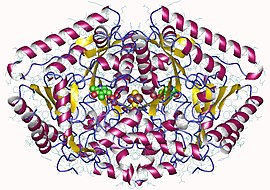| 4-aminobutyrate transaminase | |||||||||
|---|---|---|---|---|---|---|---|---|---|
 4-Aminobutyrate transaminase homodimer, Pig | |||||||||
| Identifiers | |||||||||
| EC no. | 2.6.1.19 | ||||||||
| CAS no. | 9037-67-6 | ||||||||
| Databases | |||||||||
| IntEnz | IntEnz view | ||||||||
| BRENDA | BRENDA entry | ||||||||
| ExPASy | NiceZyme view | ||||||||
| KEGG | KEGG entry | ||||||||
| MetaCyc | metabolic pathway | ||||||||
| PRIAM | profile | ||||||||
| PDB structures | RCSB PDB PDBe PDBsum | ||||||||
| Gene Ontology | AmiGO / QuickGO | ||||||||
| |||||||||
| 4-aminobutyrate transaminase | |||||||
|---|---|---|---|---|---|---|---|
| Identifiers | |||||||
| Symbol | ABAT | ||||||
| NCBI gene | 18 | ||||||
| HGNC | 23 | ||||||
| OMIM | 137150 | ||||||
| RefSeq | NM_020686 | ||||||
| UniProt | P80404 | ||||||
| Other data | |||||||
| Locus | Chr. 16 p13.2 | ||||||
| |||||||
In enzymology, 4-aminobutyrate transaminase (EC 2.6.1.19), also called GABA transaminase or 4-aminobutyrate aminotransferase, or GABA-T, is an enzyme that catalyzes the chemical reaction:
- 4-aminobutanoate + 2-oxoglutarate succinate semialdehyde + L-glutamate
Thus, the two substrates of this enzyme are 4-aminobutanoate (GABA) and 2-oxoglutarate. The two products are succinate semialdehyde and L-glutamate.
This enzyme belongs to the family of transferases, specifically the transaminases, which transfer nitrogenous groups. The systematic name of this enzyme class is 4-aminobutanoate:2-oxoglutarate aminotransferase. This enzyme participates in 5 metabolic pathways: alanine and aspartate metabolism, glutamate metabolism, beta-alanine metabolism, propanoate metabolism, and butanoate metabolism. It employs one cofactor, pyridoxal phosphate.
This enzyme is found in prokaryotes, plants, fungi, and animals (including humans).[1] Pigs have often been used when studying how this protein may work in humans.[2]
- ^ "4-aminobutyrate aminotransferase - Identical Protein Groups - NCBI". www.ncbi.nlm.nih.gov. Retrieved 2020-09-29.
- ^ Iftikhar H, Batool S, Deep A, Narasimhan B, Sharma PC, Malhotra M (February 2017). "In silico analysis of the inhibitory activities of GABA derivatives on 4-aminobutyrate transaminase". Arabian Journal of Chemistry. 10: S1267–75. doi:10.1016/j.arabjc.2013.03.007.
